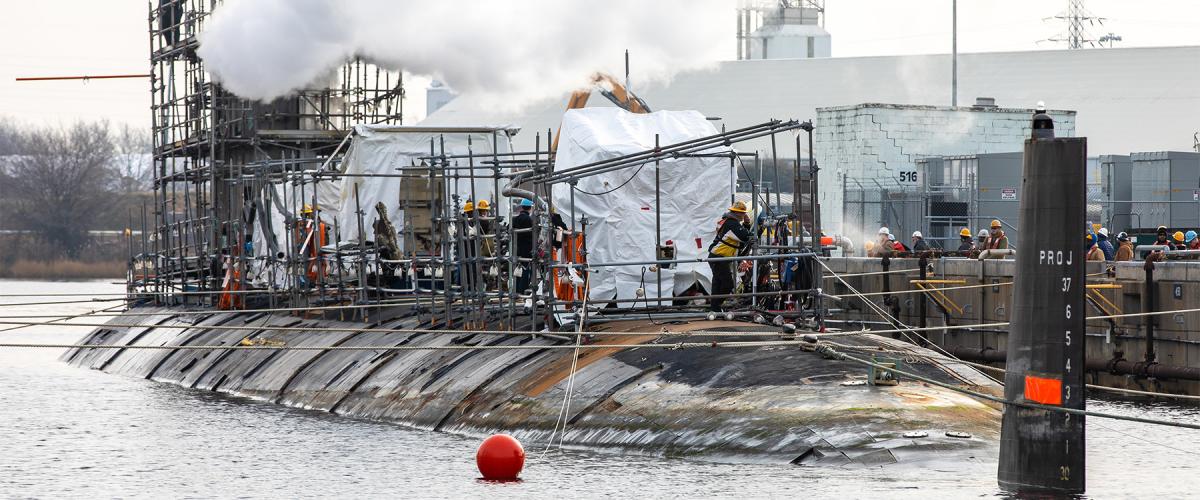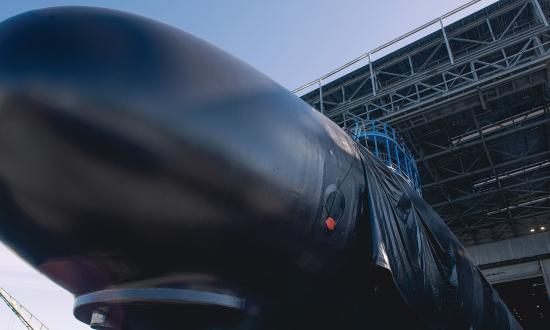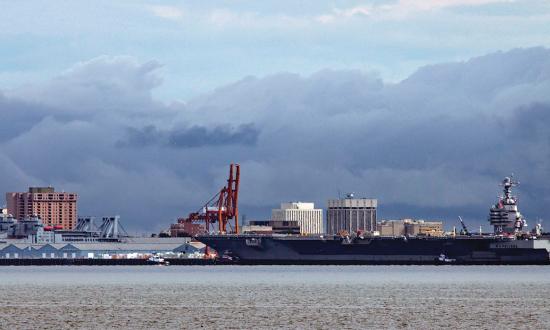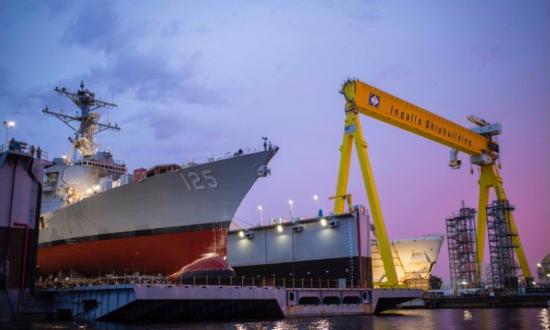For more than a decade, the Navy has lacked the industrial capacity to properly maintain its nuclear-powered attack submarines (SSNs). There is no element of maritime warfighting effectiveness not hinged to SSN effectiveness. While the Navy and its industry partners have addressed this growing maintenance problem using legacy tools, SSN operational availability has continued to decline. More than one-third of the nation’s SSNs are in extended maintenance availabilities vice being at sea.
The Navy needs more industrial capacity. However, stiff competition within a sea of tight budgets requires creative solutions and willing partners within private industry. The submarine challenge includes insufficient submarine maintenance capacity and capability, increased submarine demand, and the need for expanded funding amid a tight budget environment.
Declining U.S. Submarine Operational Availability
The submarine maintenance challenges have unavoidably impacted the operational availability of the Navy’s SSN fleet. The General Accountability Office (GAO)noted this problem in its November 2018 report. Additional reports by GAO and the Congressional Research Service (CRS), Congressional Budget Office (CBO), and the Navy itself have documented the issue. The crisis has been both extensively covered in defense trade press articles and has been the subject of numerous Congressional hearings. A 22 June 2023 CRS report has further increased attention on the issue, highlighting that 37 percent of the Navy’s nuclear-powered attack submarines are unavailable for service; and even more noteworthy, that the trajectory is worsening.
Two private submarine shipbuilders have been called to serve as a relief valve for an overwhelmed public naval shipyard system; but the reality is that they, too, are overwhelmed.
Increased Submarine Demand Domestically and AUKUS
Recently, the Office of Naval Intelligence published a viewgraph documenting the immense relative shipbuilding capacity imbalance of China and the United States, further raising concerns regarding China’s advancements and intentions. The relative strength of opposing industrial capacities is historically profound in winning a long-term conflict, recovering for follow-on obligations, and returning to and sustaining status quo deterrence. As the United States attempts to rebuild the defense industrial base—downsized following the end of the Cold War—submarine construction has fallen well short of the targeted two new Virginia-class SSNs per year and maintenance well behind in fundamental scheduling and implementation. Key contributors to both construction and maintenance struggles have been vendor industrial base capacity shortfalls and a fragile, inexperienced skilled trade-labor pool.
Further industrial base stress is anticipated with the recently announced United States, United Kingdom, and Australia (AUKUS) security partnership—an effort principally to provide Australia with a critically needed SSN capability. Under this agreement, the United States and the United Kingdom will team with Australia to provide highly specialized industrial capacity and capability—a multidecade effort. However, unless submarine shipbuilding capacity is increased prior to maturation of the AUKUS effort, and/or overall burden is lessened via additional maintenance capacity, the United States and United Kingdom will be forced to fit additional AUKUS hulls into a lineup that already yields no daylight—further exacerbating existing delays and additional loss of SSN operational availability. There is already a deep bipartisan concern in Congress regarding the capacity of the submarine industrial base to accommodate AUKUS obligations without materially degrading core U.S. defense capabilities, seen in Senator Roger Wicker’s (R-MS) July 2023 op-ed in the Wall Street Journal:
Worse still, demands on our submarine maintenance capabilities have also stretched our military’s readiness. Nearly 40 percent of U.S. attack submarines cannot be deployed because of maintenance delays. For example, the USS Connecticut had an accident in the South China Sea in 2021 and likely won’t be operational until 2026.”
The Navy Response Needs Assistance
The Navy initiated the Shipyard Infrastructure Optimization Program (SIOP) in response to the much-needed recapitalization of the four public naval shipyards. Portsmouth Naval Shipyard and Norfolk Naval Shipyard are both older than the United States itself. The other two, Puget Sound Naval Shipyard and Pearl Harbor Naval Shipyard, are well past the century mark. The SIOP includes a planned $21 billion reinvestment over the next two decades, calculated to match executability. However, this is only workable if the existing shipyards find relief via new, additional capacity affording the opportunity to transfer workload, rebuild, realize a return on the naval sustainment system–shipyards (NSS-SY), and come back stronger.
Historical Parallels to World War II
World War II exemplifies a time when the nation’s industrial might was mobilized to meet unprecedented demands. During the war, the U.S. shipbuilding industry dramatically expanded its capacity to construct a vast number of ships. This success was a testament to U.S. capitalism, innovation, and entrepreneurial action. Similarly, today’s submarine maintenance crisis demands a forward-thinking approach that mirrors the determination and resourcefulness exhibited during World War II. Today, the imperative to strengthen shipbuilding and maintenance capabilities has never been greater.
The Components of a Responsive Plan
To be responsive to both immediate and longer-term submarine industrial base ship maintenance requirements, the components of a responsive plan should:
- Provide a Component Repair Center to De-Bottleneck Depot Maintenance. The plan must initially focus on the development of a component repair center (CRC), which should be logistically well-connected to the four naval shipyards. The CRC should provide the full spectrum of industrial facilities required to maintain, repair, and rebuild key equipment, ranging from the vertical launch equipment near the ship’s bow to the propulsion shaft at the ship’s stern—and everything in between. Thinking broadly, the CRC also can provide support to eliminate key bottlenecks in building new submarines.
- Provide a Robust Rotatable Pool to Accelerate Depot Maintenance. The plan should provide a robust rotatable equipment pool, to be managed in conjunction with the CRC. This would enable a full set of installation-ready equipment to be on the dock at the shipyard when a submarine arrives for depot maintenance. This is expected to reduce the duration of a typical two-year submarine depot maintenance period by about 100 days. This feature, which requires the CRC to be sustainable, would increase the capacity of the existing naval shipyards by approximately 14 percent because of accelerated throughput.
- Provide a Fifth Naval Shipyard to Expand Capacity. This new naval shipyard, if built, must reflect the lessons learned over the past 70 years of nuclear-powered submarine development and operation in the Navy. It should be compact but flexible and provide a robust capacity. Ideally in a single large climate-controlled building, two “super-docks” should be provided so that normally two submarines can be docked but provide the emergent capacity to double that without sacrificing throughput on any single ship’s depot maintenance period. The notional 14-percent capacity improvement offered by the CRC and robust rotatable equipment pool, along with other ongoing efforts to improve performance at the existing naval shipyards, might be enough. However, factoring in the AUKUS commitments and the modern threat environment, lacking a fifth naval shipyard would mean the Navy would only be one event, such as the USS Connecticut (SSN-22) grounding in October 2021, away from overloading the system once again—not to mention the issue of properly maintaining the 35-percent larger target fleet of 66 SSNs. It is essential to have designed-in available surge capacity, which means the fifth naval shipyard is less an option than a solid requirement.
- Provide an Immediately Actionable Plan. The plan must be immediately actionable. First, it must be affordable to implement within the current Future Years Defense Program without needing to sacrifice other key priorities. Because developing and building the CRC, providing a robust rotatable pool of equipment, and building a fifth naval shipyard is a multibillion-dollar investment, this can only mean that an innovative and unique financial plan is needed to facilitate access to the vast U.S. capital markets. As in World War II, the strength of the capital markets combined with U.S. entrepreneurialism can readily solve this seemingly immense problem. The United States rapidly scaled productive capacity then; it can be done again. Second, it means that all the legislation required to implement the plan should have already been enacted. The time to act is now.
The Need to Get Going
The urgency of the Navy’s submarine maintenance crisis, particularly in the face of the current challenges with China’s naval expansion, necessitates bold and innovative responses. In 1952, the United States took the germ of an idea, which the best industry experts forecast would take 15 years to develop and sent USS Nautilus (SSN-571) to sea, underway on nuclear power just three years later. Drawing inspiration from the nation’s historic achievements during World War II, it is imperative that a plan that meets the moment be immediately developed and implemented. The time to act is now.






